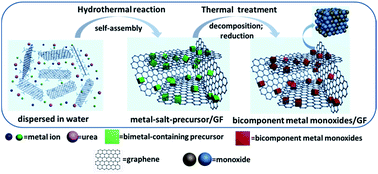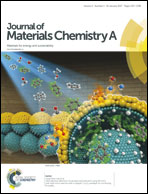General synthesis of graphene-supported bicomponent metal monoxides as alternative high-performance Li-ion anodes to binary spinel oxides†
Abstract
Engineering two transition metals into an integrated spinel oxide anode provides great opportunity towards high-performance lithium-ion batteries (LIBs). Spinels with high-valence transition metal oxides (TMOs) however tend to exhibit low initial coulombic efficiency (ICE) due to the irreversible Li2O generated during the first discharge process. Herein, we report a simple and general strategy to synthesize elaborate graphene framework (GF) supported low-valence bicomponent transition metal monoxide anodes (e.g., ZnO–MnO microcubes, ZnO–CoO polyhedra, NiO–CoO nanowires, and (FeO)0.333(MnO)0.667 microspheres, etc.), which can efficiently address the low ICE issue. As a proof of concept demonstration, we show that the ZnO–MnO/GF is indeed more advantageous as an LIB anode over the spinel ZnMn2O4/GF counterpart as well as many other ZnMn2O4-based anodes. Benefiting from the enhanced reversibility of Li+ uptake/extraction and graphene hybridization, the ZnO–MnO/GF electrode exhibits significantly improved ICEs at various current densities, superior rate capability (286 mA h g−1 even at a high current density of 6 A g−1; ∼2.9 min charging/discharging), and extended cycling life (1123 mA h g−1 after 300 cycles) with respect to ZnMn2O4/GF. Such improvements have also been observed for the ZnO–CoO/GF electrode and other analogues. This versatile electrode design could advance our understanding and control of complex TMO-based anodes to gain high ICE and capacity.


 Please wait while we load your content...
Please wait while we load your content...